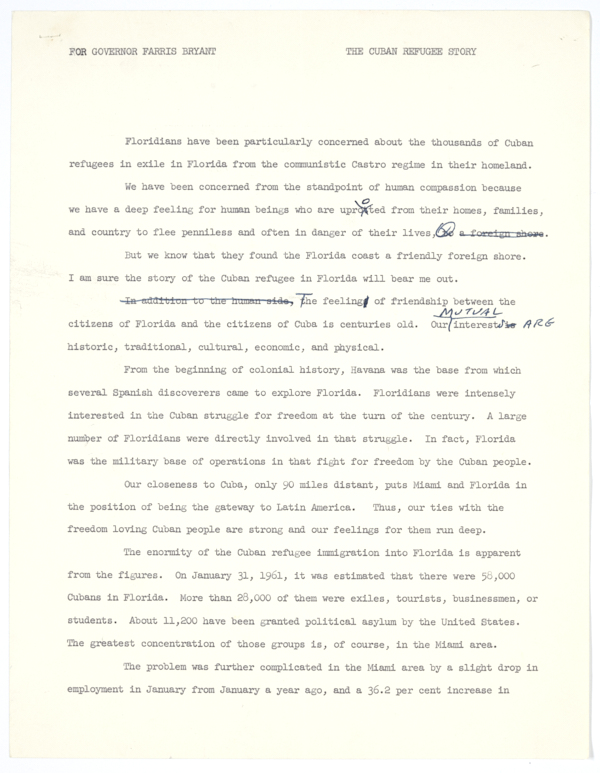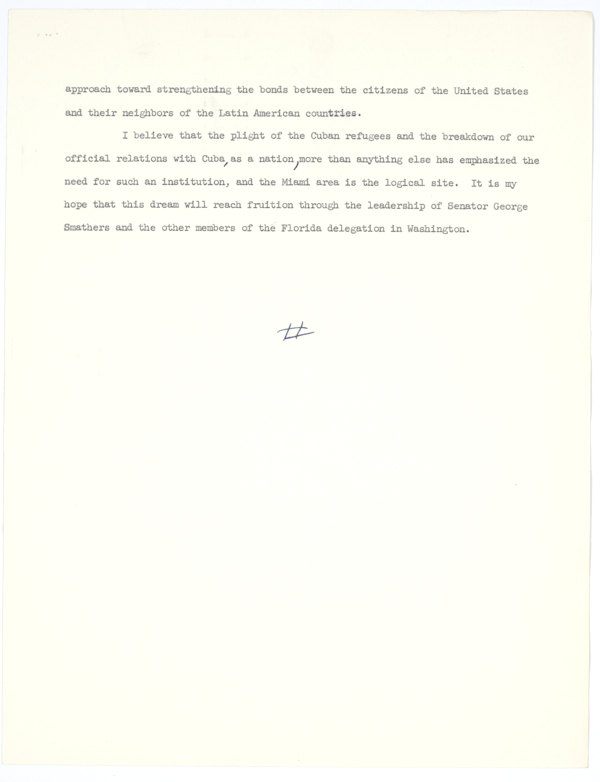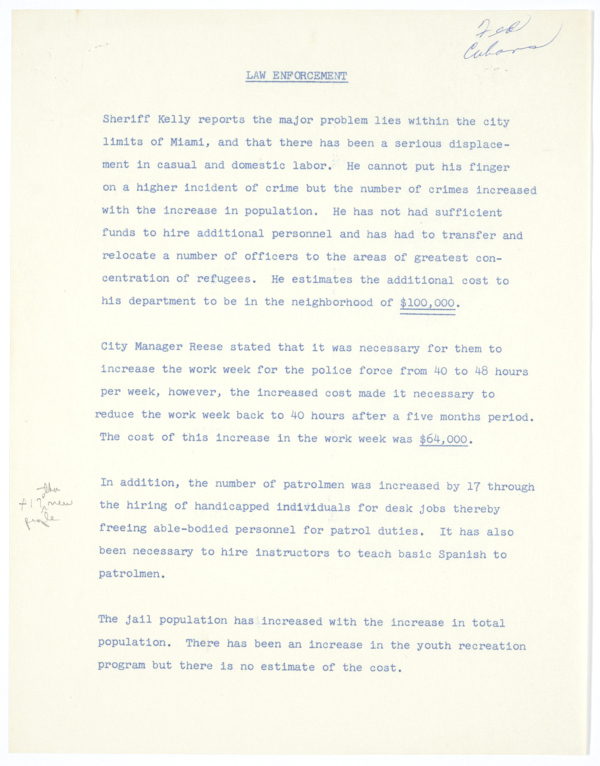Transcript
FOR GOVERNOR FARRIS BRYANT
THE CUBAN REFUGEE STORY
Floridians have been particularly concerned about the thousands of Cuban refugees in exile in Florida from the communistic Castro regime in their homeland.
We have been concerned from the standpoint of human compassion because we have a deep feeling for human beings who are and country to flee penniless and often in danger of their lives.
But we know that they found the Florida coast a friendly foreign shore. I am sure the story of the Cuban refugee in Florida will bear me out.
The feeling of friendship between the citizens of Florida and the citizens of Cuba is centuries old. Our Mutual interests are historic, traditional, cultural, economic, and physical.
From the beginning of colonial history, Havana was the base from which several Spanish discoverers came to explore Florida. Floridians were intensely interested in the Cuban struggle for freedom at the turn of the century. A large number of Floridians were directly involved in that struggle. In fact, Florida was the military base of operations in that fight for freedom by the Cuban people.
Our closeness to Cuba, only 90 miles distant, puts Miami and Florida in the position of being the gateway to Latin America. Thus, our ties with the freedom loving Cuban people are strong and our feelings for them run deep.
The enormity of the Cuban refugee immigration into Florida is apparent from figures. On January 31, 1961, it was estimated that there were 58,000 Cubans in Florida. More than 28,000 of them were exiles, tourists, businessmen, or students. About 11,200 have been granted political asylum by the United States.
The problem was further complicated in the Miami area by a slight drop in Employment in January from January a year ago, and a 63.2 per cent increase in
unemployment over January, 1960 for a total of 26,700 this January. But the response of the people of Miami, The state of Florida, and the nation has been truly magnificent.
As the situation became acute last year, a Cuban Refugee Emergency Committee was organized in Miami. Various religious group such as the National Catholic Welfare Service, the Protestant Church World Services, and the Hebrew International Aidi Society organized to aid the refugees. There was also nonsectarian International Rescue Committee, and numerous other religious and charitable groups who gave their services and money to their cause.
On December 7, 1960 all of the groups coordinated their efforts through a Cooperative volunteer agency in a building called the Cuban Refugee Emergency Center.
It was a gigantic local effort to get food, shelter, clothing, and medical service for the refugees. The Cuban Refugee Emergency Center was a place of friendliness, hope, and service for the refugees who live always straightened, and often desperate circumstances.
There were contributions, large and small. The Texas Oil Company gave $100,000. There were volunteer workers. Some weeks the amount of money spent for these services ran as high as $15,000.
It was Miami’s heart responding to a human challenge. And President Eisenhower assigned Tracy Voohees to it. Mr. Voohees and his aids assisted with the organization and laid the groundwork for the re-location of those refugees who wished to go to other parts of the United States to get jobs, start careers, and begin life anew.
Shortly after Mr. Voorhees resigned he was succeeded by Dillon Myer,
a man with a lifetime of experience in work of this kind, to head the Cuban Refugee
Emergency Center with one of the original center officials, Mark Foster, assisting.
Our Florida State Employment Service originally staffed the center to register the refugees and outlined their skills and developed information to aid the federal agencies in setting up the present program. The national employment service,
service has a vast network of employment offices all over the nation, and it has been able to channel many refugees to areas where labor shortages exist in their particular vocations. Mr. Earl Redwine of the United States Employment Services has been in charge of much of the technical work in this phase.
President Kennedy also assigned Abraham Ribicoff, U.S. Secretary of Health, Education, and Welfare to the task. I met with Mr. Ribicoff in Miami, and, like all Floridans, I was most grateful when Mr. Ribicoff agreed that this department would finance and serve the Cuban refugee project in the amount of several million dollars . The financing, experience, and facilities of the Department of Health, Education and Welfare has given a tremendous boost to the dedicated volunteers who have done such a great service.
It has been a wonderful experience working with our fellow Americans from Cuba during their trouble. And one of the most memorable and heart warming events in this whole experience was the night 6,500 Cuban people gathered in Bayfront Park in Miami to publicly express their appreciation for what America has done for them in their exile.
Finally, there is a phase of the board program that we should consider here. In strengthening the relationships between our peoples, there is another aspect that should be fostered and developed in every way possible.
Through the efforts of civic and governmental leaders an educational program has been set up at the University of Miami to provide supplemental training for Cuban doctors and lawyers so that these professional people may be able to find their proper niche and utilize their professional training.
Incidentally, at a recent cabinet meeting, I urged State institutions to consider hiring Cuban doctors and medical technicians for positions where no qualified residents of Florida are available.
Even before I became Governor I proposed a University of the Americans which I feel would not only become a vast educational center, but also a very meaningful
approach toward strengthening the bonds between the citizens of the United States and their neighbors of the Latin American countries.
I believe that the plight of the Cuban refugees and the breakdown of our official relations with Cuba, as a nation, more than anything else has emphasized the need for such an institution, and the Miami area is the logical site. It is my hope that this dream will reach fruition through the leadership of Senator George Smathers and the other members of the Florida delegation in Washington.
LAW ENFORCEMENT
Sheriff Kelly reports the major problem lies within the city limits of Miami, and that there has been a serious displacement in casual and domestic labor. He cannot put his finger on a higher incidence of crime but the number of crimes increased with the increase in population. He has not had sufficient funds to hire additional personnel and has had to transfer and relocate a number of officers to the areas of greatest concentration of refugees. He estimates the additional cost to his department to be in the neighborhood of $100,000.
City Manager Reese stated that it was necessary for them to increase the work week for the police force from 40 to 48 hours per week, however, the increased cost made it necessary to
reduce the work week back to 40 hours after a five months period. The cost of this increase in the work week was $64,000.
In addition, the number of patrolmen was increased by 17 through the hiring of handicapped individuals for desk jobs thereby freeing able-bodied personnel for patrol duties. It has also been necessary to hire instructors to teach basic Spanish to patrolmen.
The jail population has increased with the increase in total population. There has been an increase in the youth recreation program but there is no estimate of the cost.


 Listen: The Assorted Selections Program
Listen: The Assorted Selections Program


